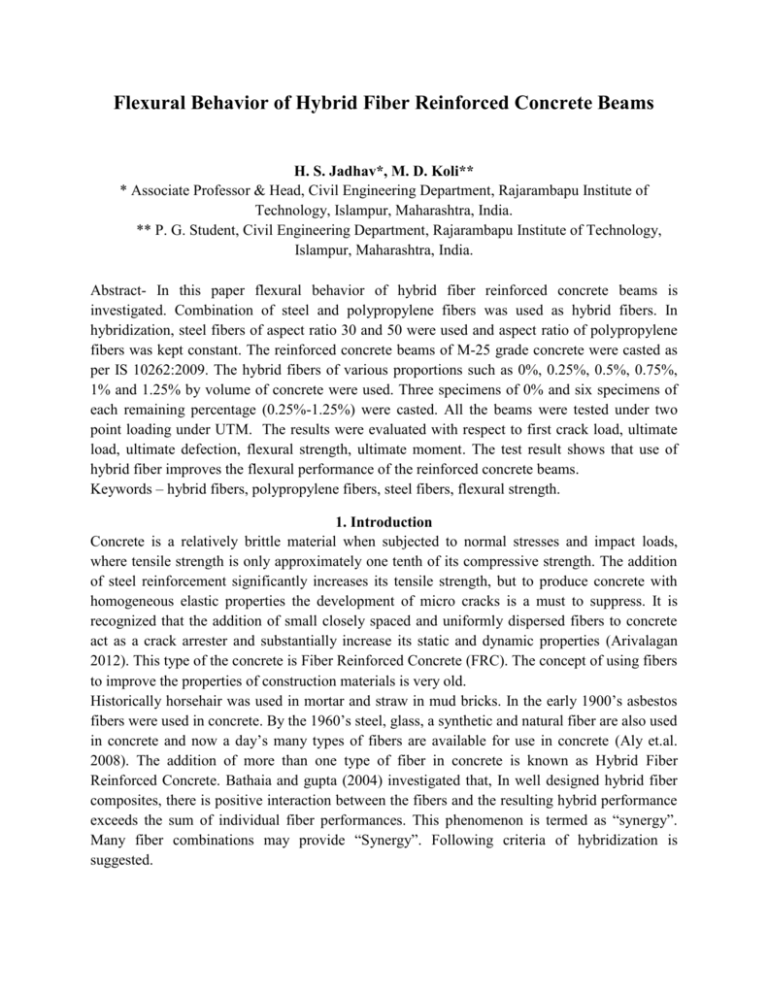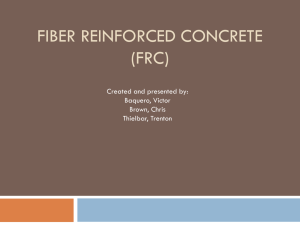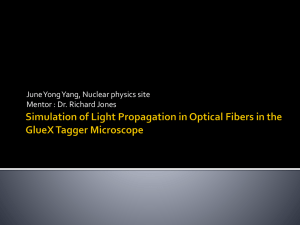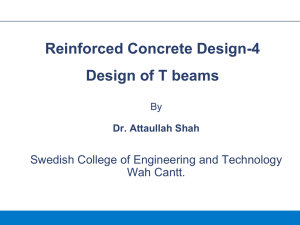Flexural Behavior of Hybrid Fiber Reinforced Concrete Beams
advertisement

Flexural Behavior of Hybrid Fiber Reinforced Concrete Beams H. S. Jadhav*, M. D. Koli** * Associate Professor & Head, Civil Engineering Department, Rajarambapu Institute of Technology, Islampur, Maharashtra, India. ** P. G. Student, Civil Engineering Department, Rajarambapu Institute of Technology, Islampur, Maharashtra, India. Abstract- In this paper flexural behavior of hybrid fiber reinforced concrete beams is investigated. Combination of steel and polypropylene fibers was used as hybrid fibers. In hybridization, steel fibers of aspect ratio 30 and 50 were used and aspect ratio of polypropylene fibers was kept constant. The reinforced concrete beams of M-25 grade concrete were casted as per IS 10262:2009. The hybrid fibers of various proportions such as 0%, 0.25%, 0.5%, 0.75%, 1% and 1.25% by volume of concrete were used. Three specimens of 0% and six specimens of each remaining percentage (0.25%-1.25%) were casted. All the beams were tested under two point loading under UTM. The results were evaluated with respect to first crack load, ultimate load, ultimate defection, flexural strength, ultimate moment. The test result shows that use of hybrid fiber improves the flexural performance of the reinforced concrete beams. Keywords – hybrid fibers, polypropylene fibers, steel fibers, flexural strength. 1. Introduction Concrete is a relatively brittle material when subjected to normal stresses and impact loads, where tensile strength is only approximately one tenth of its compressive strength. The addition of steel reinforcement significantly increases its tensile strength, but to produce concrete with homogeneous elastic properties the development of micro cracks is a must to suppress. It is recognized that the addition of small closely spaced and uniformly dispersed fibers to concrete act as a crack arrester and substantially increase its static and dynamic properties (Arivalagan 2012). This type of the concrete is Fiber Reinforced Concrete (FRC). The concept of using fibers to improve the properties of construction materials is very old. Historically horsehair was used in mortar and straw in mud bricks. In the early 1900’s asbestos fibers were used in concrete. By the 1960’s steel, glass, a synthetic and natural fiber are also used in concrete and now a day’s many types of fibers are available for use in concrete (Aly et.al. 2008). The addition of more than one type of fiber in concrete is known as Hybrid Fiber Reinforced Concrete. Bathaia and gupta (2004) investigated that, In well designed hybrid fiber composites, there is positive interaction between the fibers and the resulting hybrid performance exceeds the sum of individual fiber performances. This phenomenon is termed as “synergy”. Many fiber combinations may provide “Synergy”. Following criteria of hybridization is suggested. Hybrids Based on Fiber Constitutive Response: One type of fiber is stronger and stiffer and provides reasonable first crack strength and ultimate strength, while the second type of fiber is relatively flexible and leads to improved toughness and strain capacity in the post-crack zone. Hybrids Based on Fiber Dimensions: One type of fiber is smaller, so that it bridges micro-cracks and therefore controls their growth and delays coalescence. This leads to a higher tensile strength of the composite. The second type of fiber is intended to improve the fresh and early age properties such as ease of production and plastic shrinkage, while the second fiber leads to improved mechanical properties. Hybrids Based on Fiber Function: One type of fiber is intended to improve the fresh and early age properties such as ease of production and plastic shrinkage, while the second fiber leads to improved mechanical properties. There is a considerable research is carried out on fiber reinforced concrete containing one or more than one type of fibers. Bathia N. & R. Gupta (2004) worked on hybrid fiber reinforced concrete. They worked on a very high strength matrix of an average compressive strength of 85 MPa. Control, single, two-fiber and three fiber hybrid composites were cast using different fiber types such as macro and microfibers of steel, polypropylene and carbon. Flexural toughness tests were performed and results were analyzed to find synergy. Arivalagan S. (2012) worked on earthquake- resistant performance of polypropylene fiber reinforced concrete beams. The reinforcement and volume ratio of polypropylene fiber were kept constant for all the beams. The same dimensioned beams were tested under the positive cyclic loading and the results were evaluated with respect to crack strength, ductility, energy absorption capacity, and stiffness behavior. Mukesh Shukla (2011) has carried out an experimental investigation on behavior of reinforced concrete beams with steel fibers under flexural loading. Two types of SFRC beams were casted containing steel fibers one percent and two percent and M 20 grade concrete. Tests on conventionally reinforced concrete beam specimens, containing steel fibers in different proportions, have been conducted to establish load –deflection curves. The various parameters, such as, first crack load, service load, ultimate load and stiffness characteristics of beams with and without steel fibers have been carried out and a quantitative comparison was made on significant stages of loading. Eswari S. and Raghunath P. (2008) worked on Strength and Ductility of Hybrid Fiber Reinforced Concrete. They casted total of 54 concrete specimens were tested to study the effect of hybrid fiber reinforcement on the strength and ductility of fiber reinforced concrete. The fiber content dosage Vf ranged from 0.0 to 2.0 percent. Steel and Polyolefin fibers were combined in different proportions and their impact on strength and ductility studied. 2. Proposed Work and Material Properties Research area of flexural behavior of hybrid fiber reinforced concrete, with the use of two aspect ratios of one fiber is limited. So, an attempt was made to use steel fibers of two aspect ratio (30 & 50) with polypropylene fiber of constant aspect ratio in hybridization, at different volume percentages from 0.25% to 1.25%. And to study their flexural behavior and effect of aspect ratio on strength of concrete. Materials Used – The materials used for the experimental work are cement, sand, coarse aggregate, water, steel fibers, polypropylene fibers and super plasticizer. Cement: - Ordinary portland cement of 53 grade was used in this experimentation conforming to IS 12269-1987. Sand: - locally available natural river sand of zone Iwith specific gravity 2.66, water absorption 1.1%, and fineness modulus 2.57 .Conforming to IS 383-1970. Coarse Aggregate: - crushed basalt rock of 20mm maximum size having specific gravity 2.7, fineness modulus 7.49, conforming to IS 383-1970. Fibers- “Shaktiman Steel Fibers”, flat crimped in shape of 30mm and 50mm in length as shown in fig. 1 were supplied by the Stewols India Pvt. (Ltd.) Nagpur. Polypropylene fibers as shown in fig. 2 were manufactured by Synthetic Industries USA were used, properties of fibers are given in Table 1. Concrete Mix Proportion:Concrete of M25 grade is as per IS 10262-2009. A mix proportion of 1:2.01:3.23 with 0.52 water cement ratio to get characteristic strength of M25 was used for this study. The cement, sand, coarse aggregate were tested prior to the casting and checked for conformity with relevant Indian standards. The quantities of various materials for the concrete mix as given in Table 2. Table 1- Properties of fibers Fiber Type Shape Leng th mm Tensile strength MPa Density Kg/m3 30 Equiv -alent Dia. mm 1 Steel Fibers Steel Fibers Polypropylene Flat Crimped Flat Crimped Flat Fibrillated 1100 7850 50 1 1100 7850 12 0.6 550 910 3. Experimental Program Casting of specimens: - Beam specimens were casted of size 100mm x 150mm x 1200mm. the beam section was designed as rectangular under reinforced section according to IS 456-2000. Two bars of 8 mm at bottom as flexural reinforcement, two 8 mm diameter bars at top as anchor bar and two legged 6 mm stirrups @ 150 mm C/C were used as shear reinforcement. Percentage of reinforcement was kept constant for all beams. Fibers were distributed uniformly in dry material to avoid balling. Mixing of concrete was done by tilting type of concrete mixer. The moulds were filled with utmost care after providing sufficient cover to reinforcement. The Figure 1- Steel Fibers (Aspect ratio 30 & 50) Figure 2- Polypropylene Fibers Table 2- Material Quantities Material Quantity Cement 368.42 kg / m3 Sand(fine aggregate) 741.39 Kg/ m3 Coarse Aggregate 1192.42 Kg/ m3 Water 191.58 kg / m3 Super plasticizer 1.87 Kg/ m3 specimens were casted as shown in fig. 3. Total 6 beam specimens were casted of each percentage (0.25%-1.25%), 3 of them of 30mm steel fibers and polypropylene fibers. And remaining 3 of 50 mm steel fibers and polypropylene fibers. Same type of polypropylene fibers was used for casting. All beam specimens were cured for 28 days in curing pond. Testing of beam specimens:The flexural testing of beams was done by two point loading test by using universal testing machine of 60 kN capacity. The end conditions of beam were kept simply supported. The dial gauges (L.C-0.01 mm) were fixed under loading points and centre point of the beam to measure deflection of the beam. Load was applied at the rate of 2.5 kN up to failure of beam. First crack load, ultimate load and deflection at each 2.5 kN load increment were recorded. The test setup is shown in fig. 4 load, ultimate load and deflection at each 2.5 kN load increment were recorded. The test setup is shown in fig. 4 Figure 3- Beam Specimens Figure 4- Test Setup 4. Results and Discussion For the ease of discussion grouping of the beams is done as given in Table 3. All HY beams contain same type of polypropylene fibers and two different types of steel fibers so all the beams are designated on the basis of steel fiber aspect ratio as shown in table 3. Control beam (CB) is taken common in all groups for comparison. Fig. 5 shows load deflection curve for Group I beam. Deflections of HY1 and CB are same upto 15 kN load after that HY1 shows less deflection than CB & HY2. HY2 shows linear elastic behavior from 20kN load until failure. Ultimate deflections of HY1 & HY2 beams are nearly same, showing more deflection beyond first crack load. From Fig. 6, it is clear that all three curves are quiet parallel up to 40 kN load. After that load increment is more for HY3 than other beams. Fig.7 shows a much difference between all curves. Up to 30 kN load deflections are nearly similar for all, beyond that CB shoes more deflection than other beams. HY5 & HY6 shoes more deletion after failure of CB and Yields more load carrying capacity. From fig. 8 & 9 it is clear that, all curves shows linear elastic nature up to load of 30 kN, beyond that point HY8 & HY10 beams shows more deflection than HY7 & HY9 beams. HY7 & HY9 beams fails at higher load than HY8 & HY10 beam, Table 3- Grouping of beams Beam Designation %Fiber Beam Designations & of HY Description Beams CB, HY1, HY2 0.25% HY1- steel fiber aspect ratio30 HY2- steel fiber aspect ratio50 CB, HY3, HY4 0.5% HY3- steel fiber aspect ratio30 HY4- steel fiber aspect ratio50 CB, HY5, HY6 0.75% HY5- steel fiber aspect ratio30 HY6- steel fiber aspect ratio50 CB, HY7, HY8 1% HY7- steel fiber aspect ratio30 HY8- steel fiber aspect ratio50 CB,HY9, HY10 1.25% HY7- steel fiber aspect ratio30 HY8- steel fiber aspect ratio50 Group Name Group I Group II Group III Group IV Group V 50 45 40 35 30 25 20 15 10 5 0 60 50 40 CB HY2 HY1 load (kN) Load (kN) Note- CB- Control Beam, HY beam- Hybrid fiber reinforced concrete beam CB 30 HY4 20 HY3 10 0 1 2 3 4 5 6 7 Deflection (mm) Figure 5- Load deflection curve for Group I 0 0 1 2 3 4 5 6 7 8 Deflection (mm) Figure 6- Load deflection curve for Group II resulting more deflection. Fig. 10 & Fig.11 shows Load deflection curve for AR30 Beams, AR 50 (AR- aspect ratio) beams respectively. All the beam specimens show the flexural failure, by yielding of steel. For HY beams crack propagation is not throughout the beam depth, fibers acts as a crack arrester, and changes crack direction. From Table 4, it is clear that, as the fiber percent increases, ultimate failure load and ultimate deflections are also increases. For a beam simply supported at two ends having equal point loads at L/3 distance the maximum moment and deflection will occur at centre of beam and its value is given by – [7] M max= PL/3 Fig. 12 shows, HY beam having same percentage of fibers shows better results for aspect ratio 30 than aspect ratio 50, so graph of AR30 beams lies slightly above graph of AR50 beams. 70 60 60 50 Load (kN) CB 30 HY6 20 HY5 Load (kN) 50 40 40 CB 30 HY8 20 HY7 10 10 0 0 0 1 2 3 4 5 6 7 8 9 10 Deflection (mm) Figure 7- Load deflection curve for Group III 0 1 2 3 50 load (kN) 6 7 8 9 Figure 8- Load deflection curve for Group IV 60 40 CB 20 5 Deflection (mm) 70 30 4 HY10 HY9 10 0 0 1 2 3 4 5 6 7 8 9 10 11 12 Deflection (mm) Figure 9- Load deflection curve for Group V Table 4- Ultimate load and deflections Beam Type Ultimate load kN 65 60 55 50 45 40 35 30 25 20 15 10 5 0 40.46 47.57 45.12 51.01 48.2 55.23 51.50 58.36 56.89 59.93 58.86 Ultimate deflection mm 5.7 6.5 6.2 7.1 6.86 8.7 8.35 8.98 8.6 11.30 10.7 Flexural strength N/mm2 25.89 30.44 28.87 32.64 30.84 35.34 32.96 37.35 36.40 38.35 37.67 Ultimate moment kNm 6.74 7.91 7.52 8.5 8.03 9.205 8.50 9.276 9.48 9.98 9.81 70 60 CB 0.25% 0.50% 0.75% 0 1 2 3 4 5 6 7 8 9 10 11 12 13 Deflection (mm) Fig.10- Load deflection curve for AR30 Beam Load (kN) Load (kN) CB HY1 HY2 HY3 HY4 HY5 HY6 HY7 HY8 HY9 HY10 First crack load kN 20.16 24.33 22.40 25.3 24.7 26.43 25.5 27.75 26.9 28.12 28.00 50 CB 40 0.25% 0.50% 30 0.75% 1% 20 1% 1.25% 10 1.25% 0 0 1 2 3 4 5 6 7 8 9 10 11 Deflection (mm) Fig. 11- Load deflection curve for AR50 Beams 70 60 Load (KN) 50 40 30 ar30 20 ar50 10 0 1 2 3 4 5 Fiber Percentage from 0.25% to 1.25% Figure 12- % fibers Vs ultimate load Conclusions Ultimate deflection of the HY beams is more as compared to control beam. The maximum deflection is for HY9 beam which is two times more than control beam resulting in increase in ductility of beam. Load carrying capacity of HY beams is increasing at a constant rate for increase in fiber percentage. The maximum load carrying capacity was found for HY9 beam which is 48% more than control beam. The load carrying capacity and deflection are more for AR 30 than AR 50 beam for same percentage of fibers. Maximum increment in Load carrying capacity is for HY5 beam, which is 7.24% more than HY6 beam. Maximum increment in deflection is for HY9 beam which is 5.11% more than HY10 beam. Tension cracks were formed on both control and hybrid fiber reinforced concrete beams in middle span and shear cracks are formed near support region. The crack pattern showed that, there was no propagation of cracks throughout the depth of the beam. If fiber comes across in line of crack further crack generation was in another direction. And the width of generated cracks was very less. Moment carrying capacity of HY beams increases with increase in fiber percentage. It has 48% of maximum increment same as load increment. Acknowledgement The authors would like to acknowledge the encouragement received from director and management authorities of RIT sakharale throughout the work. Authors are also indebted to Stewols India Pvt. Ltd., Nagpur and Unitech, chemicals, Sangli for their support and providing Materials. References [1] Aly T. Sanjayan G., Collins F. (2008) “Effect of polypropylene fibers on shrinkage and cracking of concretes”, Journal of Materials and Structures, Vol.-41, pp. 1471-1753. [2] Arivalagan S., (2012), “Earthquake- Resistant Performance of Polypropylene Fiber Reinforced Concrete Beams”, Journal of Engineering and Technology, Vol.2 (01), pp.63-67. [2] Banthia N. And Gupta R. (2004), “Hybrid fiber reinforced concrete (HYFRC): fiber synergy in high strength matrices”, Journal of Materials and Structures, Vol. 37, PP. - 707-716. [3] Bureau of Indian Standards, “Concrete Mix Proportioning Guidelines (10262-2009). [4] Eswari S., Raghunath P., Suguna K., (2008), “Ductility Performance of Hybrid Fiber Reinforced Concrete”, American Journal of Applied Sciences, Vol.5 (9), PP- 1257-1262. [5] Ratwani V., Ratwani M., Duggal S. , A book of “Analysis of Structures”, Laxmi Publication [6] Shah V. & Karve S., a book of “Limit state theory & design of reinforced concrete I. S. 4562000 (2008), Structures Publications, Pune. [7] Shetty M.S., “Concrete Technology book”, S. Chand and Company, 2010. [8]Shukla M., (oct. 2011), “Behavior of Reinforced Concrete Beams with Steel Fibers under Flexural Loading”, International Journal of Earth Sciences and Engineering, Vol. 4, pp. 843-846. ABOUT THE AUTHORS Dr. H. S. Jadhav is currently working as an Associate professor and Head, Department of civil Engineering at Rajarambapu Institute of Technology, Rajaramnagar, Dist.- Sangli (M.S.). He is Ph.D. from Shivaji University, Kolhapur. He has published more than 30 papers in international, National, Journals, Conferences and workshops. He has also authored a book of Applied Mechanics. He has attended no. of STTP, seminars, workshops and conferences. He has actively involved in research and consultancy related in repair, rehabilitation and strengthening of reinforced concrete structures. He has guided more than 16 M. E. Students. He has a member of Institution of Engineers (India), Indian society for Technical Education, Indian society for Rock Mechanics and Tunneling, and Indian Association of Structural Rehabilitation. Miss. M. D. Koli is P. G. structure student, Department of Civil Engineering at Rajarambapu Instite of Technology, Rajaramnagar, Dist. - Sangli (M.S.). She has completed B. Tech. (Civil) from Walchand College of Engineering, Sangli. She has published paper in national conference. She has attended STTP, Workshop and Conference. Her area of interest is hybrid fiber reinforced concrete and effect of fiber dimensions on concrete strength.







